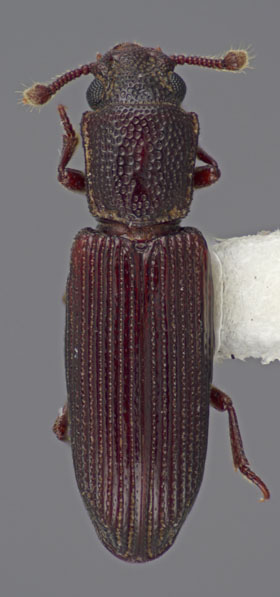 |
 Previous Genus Next Genus Previous Genus Next Genus 
Genus: Pycnomerus
Diagnostic Features
- Description: Body elongate, subdepressed. Antennae 10- or 11-segmented with distinct, 1- or 2-segmented club. Antennal setation sparse. Subantennal grooves absent. Eyes large, well-developed, finely faceted. Submentum in male with a setose pit. Pronotal disc convex, simple, sometimes with medial depressions. Procoxal cavities broadly closed. Metacoxae widely separated, separation as wide as or greater than metacoxal length. Tibia with outer angle expanded and produced into a tooth. Tarsal formula 4-4-4. Abdomen with ventrites 1-3 connate. Elytron with 10 distinct striae. Dorsal surface glabrous, shiny.
- Similar genera: The genus Pycnomerus is distinct among the genera of North America zopherids in having 4-4-4 tarsi, widely separated metacoxae, sparse antennal setation, and a shiny, glabrous body.
Known Distribution
- Northeast (DE, MD, NJ, NY, PA, VA), North Central (IL, IN, OH), Southeast (AL, FL, GA, NC, SC, TN), South Central (AR, LA, MS, OK, TX), Northwest (OR, ID), Southwest (AZ) USA. Ontario, Canada
Biology
- Pycnomerus is commonly collected under the bark of dead, rotting wood (both hardwoods and pines), on rotting palm fronds, and at MV/UV lights at night.
- Abundance: Very common.
North American Species (6)
Species Diagnoses
- Pycnomerus arizonicus: Western species. Antennal club 1-segmented. Pronotum convex, without median, longitudinal depressions. Punctures of pronotum more or less uniform in size. Lateral margins of pronotum straight to slightly sinuate. Pronotal disc evenly convex to lateral margins. Anterior angles of pronotum angulate, distinct, posterior angles rounded. Distribution: Arizona, USA.
- Pycnomerus haematodes: Eastern species. Antennal club 2-segmented. Pronotum with 2 median, longitudinal depressions. Punctures of pronotum more or less uniform in size. Lateral margins of pronotum sinuate. Pronotal disc with central area flattened or subdepressed. Anterior and posterior angles of pronotum angulate, distinct. Distribution: Indiana, Maryland, New Jersey, New York, Ohio, Pennsylvania, Alabama, Florida, Georgia, Mississippi, South Carolina, Virginia, Oklahoma, Texas, USA.
- Pycnomerus quercus: Western species. Antennal club 2-segmented. Pronotum convex, without median, longitudinal depressions. Punctures of pronotum more or less uniform in size. Lateral margins of pronotum arcuate. Pronotal disc evenly convex to lateral margins. Anterior angles of pronotum angulate, distinct, posterior angles rounded. Distribution: Arizona, USA.
- Pycnomerus reflexus: Eastern species. Antennal club 2-segmented. Pronotum convex, without median, longitudinal depressions. Punctures of pronotum more or less uniform in size. Lateral margins of pronotum arcuate. Pronotal disc evenly convex to lateral margins. Anterior and posterior angles of pronotum angulate, distinct. Distribution: Illinois, Indiana, Maryland, New Jersey, Ohio, Pennsylvania, Georgia, Mississippi, North Carolina, Louisiana, South Carolina, Tennessee, Virginia, USA; Ontario, Canada.
- Pycnomerus sulcicollis: Eastern species. Antennal club 1-segmented. Pronotum with 2 median, longitudinal depressions. Punctures of pronotum variable in size, punctures in central portion of disc larger than surrounding punctures. Lateral margins of pronotum arcuate. Pronotal disc with central area flattened or subdepressed. Anterior and posterior angles of pronotum angulate, distinct. Distribution: Delaware, Indiana, New Jersey, Alabama, Arkansas, Florida, Georgia, Mississippi, North Carolina, South Carolina, Tennessee, Virginia, Oklahoma, USA.
- Pycnomerus thrinax: Eastern species. Antennal club 2-segmented. Pronotum convex, without median, longitudinal depressions. Punctures of pronotum more or less uniform in size. Lateral margins of pronotum arcuate. Pronotal disc with central area flattened or subdepressed. Anterior and posterior angles of pronotum rounded. Distribution: Known only from the Florida Keys, Florida, USA.
Potential Problems with Identification
- It is possible that a West Indian species, Pycnomerus infimus Grouvelle, XXX, might also occur in the Florida Keys area. This species is extremely similar to Pycnomerus thrinax (above), and can be differentiated from P. infimus in having round pronotal punctures, pronotum lacking longitudinal wrinkles, and sides of elytra sinuate medially. In P. infimus, the pronotal punctures are elongate, londitudinal wrinkles on the pronotum are present, and the sides of the elytra are straight.
Selected References
|
 |
 
Pycnomerus arizonicus
© N.P. Lord |


